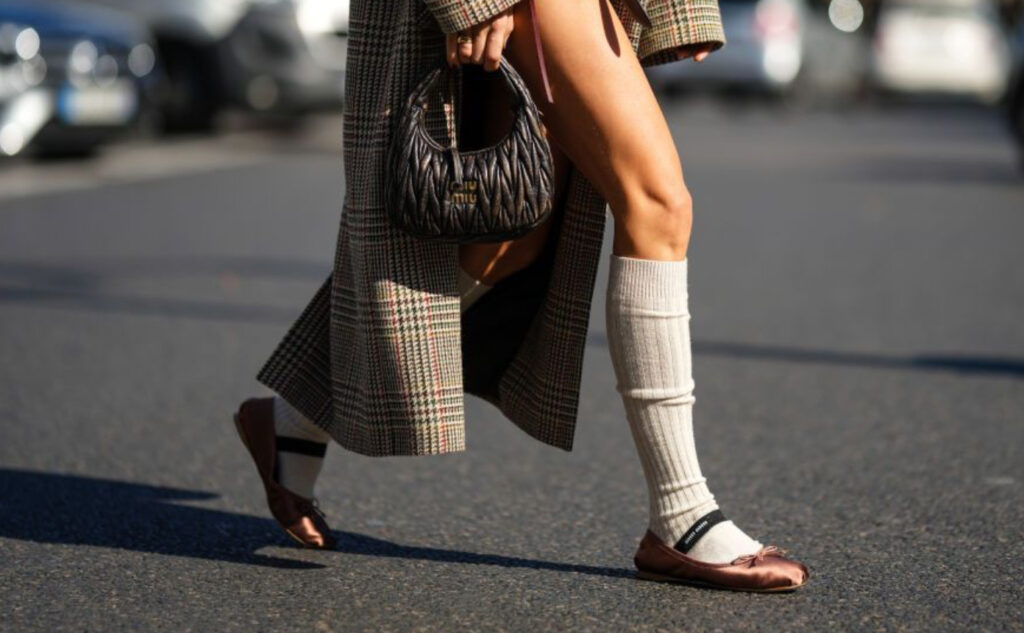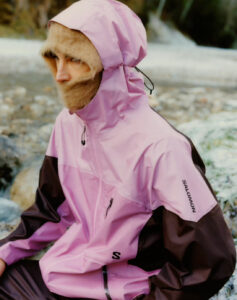In New York City, where sidewalks double as runways and crosswalks frame editorial shots, style has always been less about following rules and more about rewriting them. But this season, the city’s fashion crowd has embraced a theory so deliciously disruptive it’s reshaping the very architecture of dressing.
The “wrong shoe theory”—once a cheeky styling hack whispered among fashion editors and substack stylists—has officially gone mainstream feral, and in the best, most radically chic way.
Forget matching footwear to your outfit. Forget harmonizing texture, proportion, or event-appropriateness. In NYC right now, the wrong shoe is the right choice. Picture this: a sheer slip dress billowing in a breeze, not grounded by a delicate sandal, but by heavy leather loafers. Or a silk midi skirt not paired with heels, but barely-there flip-flops. And the kicker? It works. Not in an ironic way, but in a way that feels decisively modern, playfully irreverent, and unmistakably New York.
How the “Wrong Shoe Theory” Got It Right
At its core, the wrong shoe theory is about intentional tension. The concept? Pair an outfit with the least expected footwear—stylistically, tonally, or texturally—and you create an entirely new visual language. The result is always arresting. It’s a formula that operates by refusing formula: feminine meets masculine, tailored meets casual, polished meets grungy. The clash isn’t just embraced; it’s exalted.
First coined (and widely discussed on TikTok and fashion forums) as a way to shake up predictable looks, the theory was originally applied to more controlled contrasts: trainers with dresses, combat boots with floral prints. But this season, New Yorkers have evolved it into something more radical. The goal isn’t to balance anymore—it’s to break.
What the “Wrong Shoe” Signals Today
Fashion always functions as code, and the wrong shoe is saying something loud and clear: you’re not here to play by the old rules. This form of styling isn’t just about visuals—it’s about values. It’s subversive, defiant, and anti-uniform. In a cultural moment obsessed with authenticity and individuality, the wrong shoe theory becomes a tool of personal storytelling.
Take the fashion editor who shows up to a press preview in vintage boxer shorts and pristine knee-high boots. Or the SoHo creative wearing foam Birkenstocks with a tailored linen suit. It’s giving I get it—but I don’t need you to. That’s the genius of the trend: it challenges you to look twice and forces you to ask, wait, why does that actually look…good?
Clash, Contrast, and Control: Styling Without Safety Nets
This movement thrives on visual contradiction. The magic lives in combinations that shouldn’t work but absolutely do. Here’s how it’s playing out on the streets:
- Silk Skirts + Flip-Flops: The fluid elegance of a bias-cut skirt is suddenly nonchalant when paired with beach-ready rubber. Think minimalist chic with a whisper of absurdity.
- Boxer Shorts + Moto Boots: The softness and domesticity of men’s underwear flipped into a power statement with chunky, stomping boots. Undone meets unapologetic.
- Sheer Dresses + Loafers: A whisper of femininity grounded by heavy, intellectual footwear. It’s giving art student at a gallery opening—bookish but bold.
- Cargo Pants + Ballet Flats: Utilitarian function collides with dainty romanticism. The girly/gutsy juxtaposition is pure styling heaven.
- Tailored Suiting + Hiking Sandals: Peak juxtaposition. A structured blazer and crisp trousers become something completely new when thrown off-kilter with Tevas.
The Psychology of Dressing Against the Grain
Fashion insiders have long understood that dressing isn’t just aesthetic—it’s psychological. Wearing the “wrong” shoes messes with symmetry, interrupts predictability, and disorients expectations. And that’s where freshness lives. It’s a refusal to over-style. It says, I didn’t try too hard, but I still have control over how this makes you feel.
There’s also something empowering about resisting the outfit-pressure vortex. You don’t need a new dress—just your dad’s New Balances. You don’t need another pair of strappy sandals—just wear your Docs. The wrong shoe theory repurposes old pieces, gives them new context, and makes your wardrobe feel infinite.
Influence from Runway to Sidewalk
While the trend feels organic and street-born, its roots stretch into recent runway history. Designers like Miuccia Prada, Demna, Raf Simons, and Marine Serre have long leveraged footwear chaos as a way to explore dissonance and disrupt cohesion.
- At Miu Miu, ultra-femme micro minis were styled with stiff, practical Mary Janes.
- Balenciaga sent suits down the runway with Crocs and sneaker-sandal hybrids.
- Sandy Liang’s balletcore silhouettes clashed beautifully with Salomons and skate shoes.
In New York, this influence has filtered down from Fashion Week front rows to the Fulton Street subway station. On the Lower East Side, you’re just as likely to see clogs under a bodycon dress as you are polished brogues with parachute pants.
Why NYC Is the Perfect Breeding Ground for the Trend
New York is a city of contradictions. Brutalist buildings house jewel-box boutiques. Noise pollution accompanies spiritual stillness. It’s high fashion and high heat, sweat and sequins, urgency and indifference. This duality makes it the ultimate lab for wrong shoe styling.
The city’s sidewalks demand footwear that can survive the day, but its social culture insists you look like you didn’t sweat it. So what’s the solution? A fit that’s about comfort and conflict. The wrong shoe is often the practical one. It lets you live in your look.
New Yorkers, by nature, are also allergic to trend-chasing. They want edge, narrative, and just a touch of irony. The wrong shoe theory gives them all three. And in a post-pandemic fashion culture where taste is increasingly democratic, the people have declared: ugly shoes, wrong shoes, rule-breaking shoes—they’re cool now.
Minimal Shopping, Maximum Recontextualizing
Perhaps the best part of this trend is that you don’t need to overhaul your closet. It’s a reimagining exercise. That pair of ballet flats you forgot about? Try them with carpenter jeans and a cropped blazer. Those neon trail runners gathering dust? Pair them with a slip dress and a leather trench. The styling twist breathes new life into basics.
Fashion has been veering away from overconsumption and toward intentional reinvention. This movement plays into that. It says: you don’t need more—you just need a new lens.
A Few of Our Favorite Summer Looks (So Far)
- The Slip Dress + Basketball Sneakers Combo
Seen in Williamsburg, this look was the epitome of controlled chaos. The sheen of the dress paired with beat-up Jordans felt punk, romantic, and streetwise all at once. - Boxers, Blazer, Boots
At a rooftop party in Tribeca, a partygoer wore pinstriped boxer shorts, an oversized linen blazer, and square-toe knee-high boots. No pants required. - Mini Kilt + Dad Shoes
In SoHo, a fashion assistant paired a schoolgirl pleated mini with oversized mesh New Balances and calf-high white socks. Think sport goth meets street ballet. - Tailored Vest + Hiking Sandals
Seen outside a press preview, this outfit married a sharply tailored menswear vest with slouchy trousers and Tevas—sophisticated with a slice of sarcasm. - Tulle Skirt + Combat Boots
A girl in the East Village made princesscore look subversive, pairing layers of pink tulle with thick-soled combat boots and a baby tee.
Cool Is Contextual—and the Wrong Shoe Gets It
In 2025, cool isn’t about luxury logos or rigid trend cycles. It’s about interpretation. About play. About context over conformity. The “wrong shoe theory” invites everyone to be a stylist, a disruptor, a maker of micro-chaos.
Whether it’s an act of resistance, a quest for originality, or just an honest desire to wear what feels good, this trend proves something powerful: rules don’t make style. Tension does.
And nowhere is that more beautifully chaotic—or more authentic—than the streets of New York City.
No comments yet.








